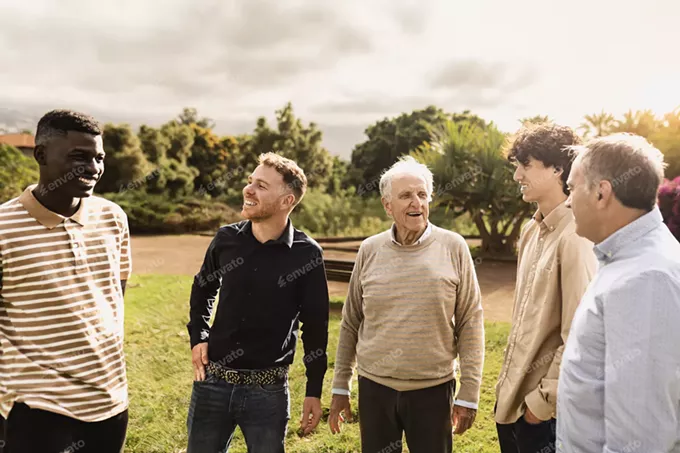Mental health can often be a difficult and uncomfortable subject to talk about. At various points throughout history, an admission of poor mental health could result in wildly different responses - from being shunned by society to broad acceptance and support of those experiencing distress.
This varied experience has had an impact on how different generations choose to talk about mental health, with their individual experiences being reflected by the attitudes and perceptions of mental health fostered by the generation before them.
While we’ve come a long way since the poorly considered mental health treatments of the 19th century, one of the common challenges faced by counselors is navigating the unique perspectives that each generation has on mental health and wellbeing.
Let’s explore some of the unique issues that different generations face — what can we learn from different generations, to help improve mental health outcomes for those that need support?
Different Times, Different Challenges
It’s important to recognize that generational change has had an immense impact on how we discuss illness and disease, particularly in the last one hundred years. A century ago, a mental health condition was often accompanied by an extended stay in a ‘mental asylum’ — even for minor mental health maladies or conditions that would no longer be considered a mental health condition (such as hysteria).
The presence of these mental institutions presented a unique set of challenges for those who did struggle with mental illness — for many families, a mindset was formed that dealing with mental struggles should be done in silence.
Much has changed since the 1920s. These days, society is much more open to talking about mental health. We’ve moved on from locking people in mental asylums. Instead, generations of deinstitutionalization have resulted in increased community-based care, and specialized services are much more widely available for those who need them.
While the young people of today are facing different challenges, it’s important to recognize that cultural expectations around talking about mental health have also changed. For many, we’re now at a turning point — where one can more openly talk about mental health, knowing that in many communities, they’ll be supported rather than shunned.
Facing War: The Greatest Generation
A demographic that embodies the notions of institutionalization is the Greatest Generation — born between 1901 and 1927. This generation experienced dramatic shifts in prosperity during their lifetimes — when the Great Depression saw nearly a quarter of the adult population out of work, followed by the deadliest military conflict on record in World War II.
Dealing with adversity can often place strain even on the most resilient of individuals — and for those who spent extended periods out of work or dealt with the trauma of war and conflict, it was not unusual for returned servicemen to experience mental illness.
The world was not as forgiving about mental illness as it is today, however, and this resulted in a generation that suffered in silence. For many, treatment was dangerous, unfounded, and often untested — so instead, those who struggled were largely silent.
A Generation of Stigma: Baby Boomers
Many children born to members of the Greatest Generation formed a demographic that is widely known today as the post-war baby boomers, born between 1946 and 1964. For many boomers, this generation grew up in a relatively prosperous period, where items such as refrigerators and the telephone became commonplace around the family home.
As children of the Greatest Generation, baby boomers experienced the trauma of a generation that suffered during World War II while also experiencing something similar themselves — with approximately 2.7 million Americans serving as a part of the U.S. Armed Forces during the Vietnam War.
Baby boomers experienced trauma in a way unlike that of other generations — for some, they were victims of the trauma that had been felt by the Greatest Generation, and for others, they were traumatized by the horrors of the Vietnam War.
Baby boomers were also at the forefront of a changing environment. Deinstitutionalization was beginning to reshape mental health care, enabling boomers and their children to talk more openly about mental health. However, for many, there was still a stigma around mental health and mental health care for many years of Boomers’ lives. This meant that many still felt unable to talk about their mental health or seek help.
Confronting Reality: Millennials
Millennials, born between 1981 and 1996, are often the children of Boomers and grandchildren of the Greatest Generation.
For many, financial insecurity, isolation, and shared trauma are a formative part of growing up as a millennial. The 2008 Global Financial Crisis not only destroyed lives and livelihoods but was also mentally damaging for many millennials — a generation less wealthy than those before them.
The COVID pandemic of the early 2020s highlighted that further, with isolation, job distress, and fear placing further stress upon millennials. The result? A generation with stress levels far higher than that of their parents and grandparents — but a generation that is much more open to talking about their issues, especially when it comes to talking about mental health.
Millennials present an interesting paradigm — as the beneficiaries of a culture that has deinstitutionalized mental health care, they are able to confront their issues in a way that encourages open and honest communication. Conversely, they’re also facing stressors that did not apply to the generations before them — placing further stress on their mental health in a way that is unique to their generation.
What Challenges Lie Ahead?
For each generation, conversations about mental health can have wildly differing outcomes. What a century of change in mental health has shown is that attitudes, in part, can be shaped by the cultural views of the time — as can be seen with how members of the Greatest Generation responded to mental health with silence and restraint while millennials today are far more willing to talk about their struggles.
What about the next generation, though? How will the attitudes of their parents shape Generation Z — will their views be influenced by the struggles their parents faced, or will they be guided by the open conversations about mental health that millennials are having today?
It appears that at least, for now, the cat is out of the bag. and talking about mental health will continue to evolve. Perhaps the challenge isn’t so much about how we continue to foster conversations about mental health, maybe it’s about making sure that services are in place so that people are adequately supported in their times of need.









